Sword Duel: Its History, Rules, and Customs
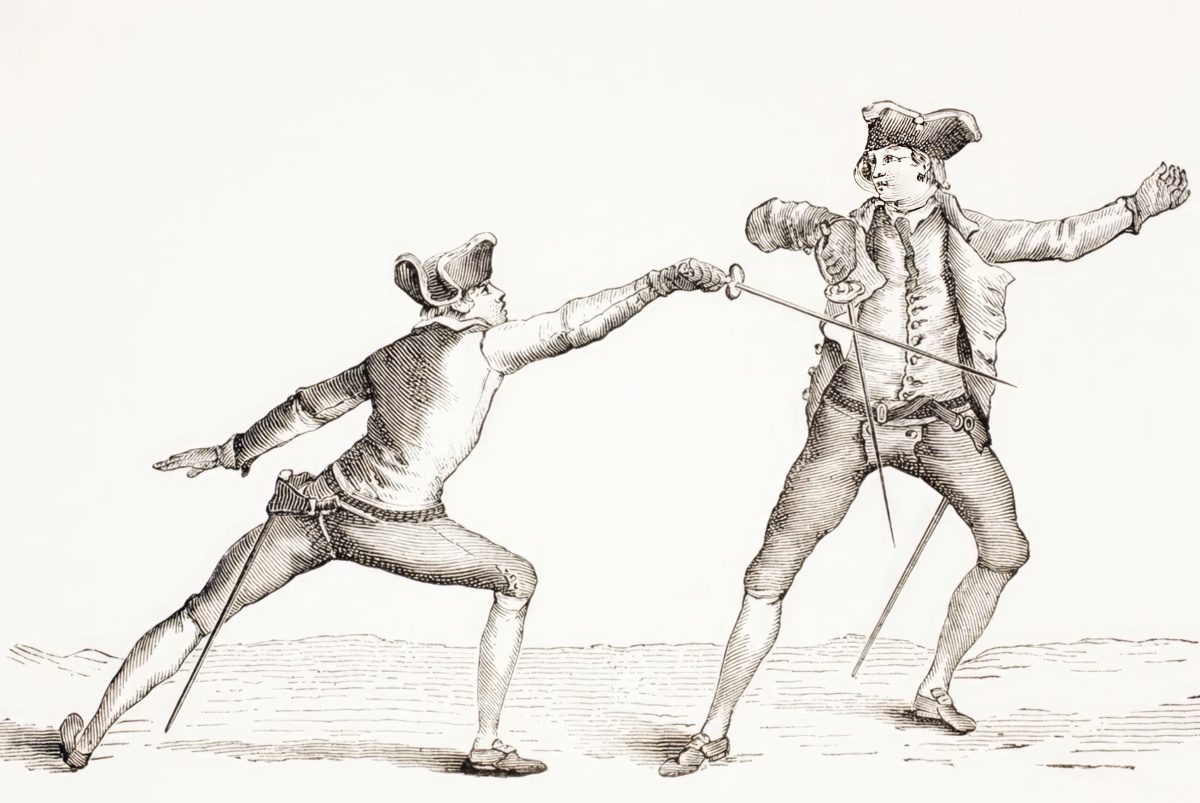
What’s in this article?
Throughout history, sword duels became a means of settling disputes and restoring lost honor. They had various types, from trial-by-single-combat or judicial duels to private honor duels. There were several reasons why duelists entered a sword duel, and the rules and customs also varied from the early Middle Ages to the early modern period.
Let’s explore the history of sword duels, their cultural variations, and the types of swords used.
Types of Sword Duel
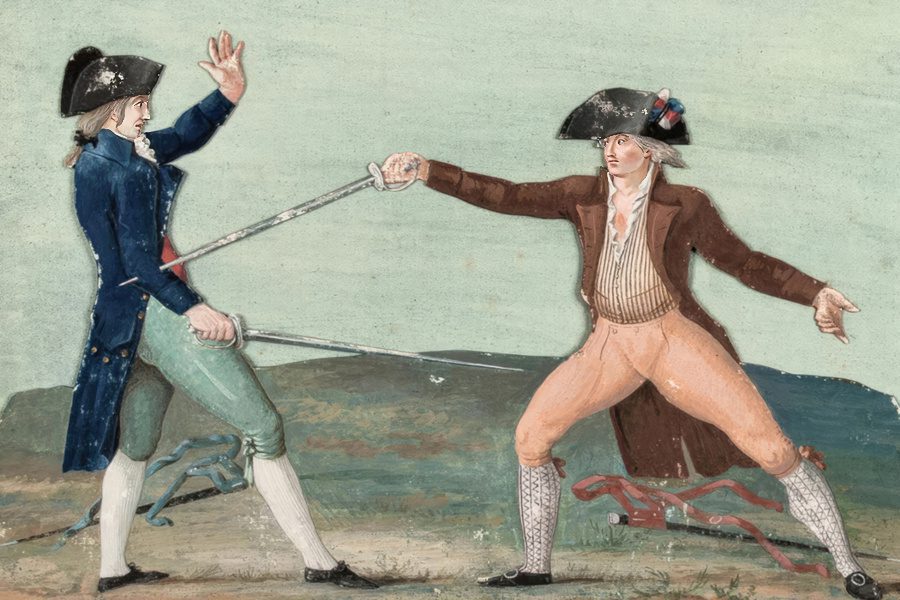
A sword duel was a pre-arranged combat between two individuals armed with swords. The medieval judicial duel was part of the legal process and fought over a severe crime. On the other hand, the post-medieval duel of honor was often illegally fought because nobles felt their honor was slighted.
1. Judicial Duel
The judicial duel was a legal practice conducted before the magistrate and the public. Generally, one would declare before a judge that his opponent was guilty of a crime. If the opponent claims that his accuser lied, the judge might call them to fight in a sword duel, in the belief that the judgment of God would determine the winner. If still alive after the sword duel, the loser was dealt according to the law.
2. Duel of Honor
In honor duels, no crime was involved. The duel of honor emerged when several nobles established themselves as a social class. Since some took their honor seriously, whenever some words or deeds diminished their sense of honor, a duelist would enter a duel to restore one’s honor—not to kill their opponent.
Honor duels were initially legitimate public events that were attended by huge crowds. They were rarely fought to the death and often ended before either duelist was seriously hurt. However, the Church and monarchs discouraged the practice, leading to many fights privately without legal sanction. These private duels evolved into illegal post-medieval honor duels.
Rules and Customs in a Sword Duel
Several dueling codes, also Code Duelo, set the etiquette for sword duels. These often included a specific set of rules that duelists agreed to beforehand. These provided an equal advantage to each duelist and also limited casualties.
There were several reasons for challenging an opponent to a duel.
Generally, there was a high stake struggle between two duelists. Reasons may include murder, treason, betrayal, falsehood, tarnished reputation, or personal slight. Others were about disputes over the rightful ownership of land.
In judicial duels, there must be reasonable grounds to suspect the accused. Before the actual combat, the accuser swore his testimony was true, while the accused swore his innocence.
Rules in judicial duel varied in different periods and regions.
In the French Ordinance of 1306, judicial duels were only allowed in certain circumstances. Generally, a crime that had been committed must be punishable by death, as at least one duelist was likely to die. Also, there must be no other way to prove or disprove the matter by documents or witness testimony.
A sword duel was a mutual agreement between duelists.
After a duelist issued a formal challenge, the date and venue would be agreed to. In judicial duels, the accused could even be imprisoned if he was likely to flee. On the other hand, respected men were sometimes released on sureties, letting them settle their affairs and train. However, failure to appear on the day itself would be considered a confession of guilt.
Sword duels had rules on how to start and finish the combat.
For instance, one would throw down his gauntlet as the challenge, then the opponent would accept it by picking it up. Depending on the agreement, a sword duel would be stopped until the first blood was drawn, one was disarmed, severely injured, or died.
Commoners could fight judicial duels, though they could rarely challenge nobles.
Judicial duels among commoners were often between craftsmen. Among nobles, dueling often began on horseback with lances and continued on foot with longswords. Other nobles only fought dismounted with longswords or poleaxes.
The elderly, clergy members, and children were exempted from judicial duels.
Some towns exempted their inhabitants from having to fight judicial duels. Some disabilities, such as a missing limb or eye, also prevented sword duels. Sword duels between women also occurred, although rare.
However, judicial duels could be abused. After the deposition of King Richard II of England, some infirm and elderly nobles were maliciously accused of treasonable words against the king and then forced to defend themselves against young and well-trained accusers.
The duelists in judicial duels often trained with a sword master.
Some duelists had six weeks to prepare for a judicial duel and trained with a respectable fencing master. Some men even sought out a notable fencing master before issuing a challenge for a duel, hoping to learn some secret techniques that might give them an advantage.
Duels were fought with various weapons besides swords.
While sword duels were combat between two men armed with swords, the duel generally utilized various types of weapons. Many armored duels started with spears, which might be thrown at the opponent, before switching to swords. Some commoners also fought with specialized two-handed spiked dueling shields or with clubs and shields.
The duelists often discarded their scabbards after drawing their swords.
In judicial duels, swords were not re-sheathed, so duelists often discarded scabbards to prevent them from tangling between the legs. Also, some fencing masters advised drawing the sword while approaching the dueling field to avoid being surprised. Others also used a sword in a scabbard to defend against an opponent using a dagger.
Types of Swords Used in Dueling
Sword duels utilized various bladed weapons throughout history. When swords became less significant on the battlefield, they became more important in civilian life, especially in dueling.
1. Viking Sword
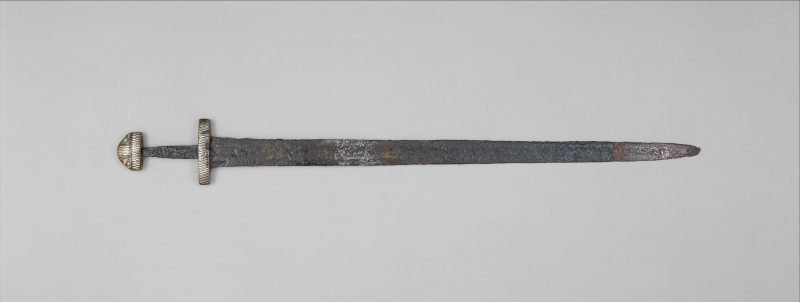
Viking swords were used in nearly all duels and seemed to be the typical dueling weapons, especially the formal duel of Vikings took place in a dueling arena that limited the movement in combat. These swords typically had a straight, double-edged blade, which fighters used for slashing. Still, some literary sources suggest that other weapons were used in dueling.
2. Arming Sword

Also known as the knightly sword, the single-handed arming sword was the classic weapon of a medieval knight. In chivalric and judicial duels, it was used with a small buckler or large shield. Generally, a buckler was a handheld shield for parrying, and the sword and buckler combination was efficient against chainmail. Eventually, the arming sword was replaced in dueling by various double-handed swords.
3. Longsword

The longsword was a versatile weapon used in judicial duels, duels of honor, wars, tournaments, and street brawls. Generally, it had an extended grip that accommodated two hands yet was lightweight enough to wield in one hand.
The longsword was usually used alone in armored combat and provided both attack and defense. In judicial duels, longswords could be used one-handed with large spiked shields, though it was uncommon.
4. Rapier
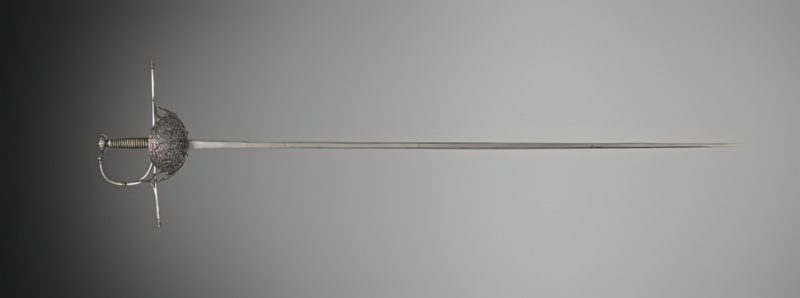
The single-handed rapier became fashionable as a civilian dueling weapon when armor was no longer practical. It was purely a thrusting weapon, and swordplay using the tip of the sword was considered a gentleman’s art. Most duelists used the rapier alone, while others used it with a parrying dagger, a buckler, or a cloak.
5. Smallsword
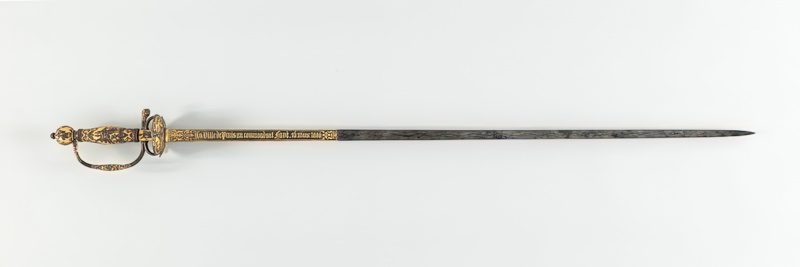
Toward the end of the 17th century, the smallsword served as a dueling sword and a civilian weapon for self-defense. The smallsword, developed from the longer rapier, was also designed for thrusting. Some had a colichemarde blade type with a broad forte for parrying an opponent’s sword. It consisted of a small cup guard and finger and knuckle guards.
6. Düsack
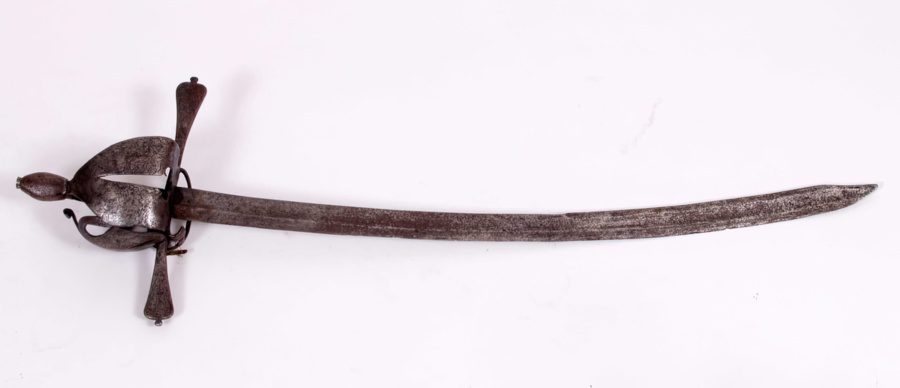
The düsack, also spelled dussak, was a south German and Austrian weapon of war. However, early 17th-century woodcuts imply that it also served as a dueling weapon in southern Germany. It has a curved blade similar to a saber, making it efficient for cutting. It also features an enclosed guard that provides excellent protection for the swordsman.
Historical Facts About Sword Duels
The term duel comes from the Latin duellum, meaning war between two. In most contexts, it implies single combat instead of military group combat.
Sword duels were not about sword training, self-defense, or public entertainment.
A sword duel was a combat between two individuals intending to settle a dispute or vindicate an honor. Hence, two swordsmen sparring with non-lethal training swords as practiced was not dueling. Also, Roman gladiatorial combats were not duels because the fighters did not have personal disputes to settle but fought for public entertainment.
Judicial duels became a means to contain the violence in feuds.
Within various law codes, violence served as a means of resolving disputes, especially if the victim wanted to seek revenge instead of compensation. However, it could lead to large-scale feuds lasting across several generations and uncontrolled violence, such as assassinations and vendettas. So, judicial duels limited casualties to two men rather than two families or armies.
Medieval fight books are valuable resources for understanding how sword duels took place.
Medieval fight books focus on sword duels, and several books from Germany and Italy reflect a greater interest in knightly dueling in those countries. Several fencing masters, including Hans Talhoffer, produced fight books teaching short swords, longswords, daggers, and dueling shields. His books also feature grappling techniques and armored judicial duels.
Some sword masters privately trained their students for sword duels.
When training his students for judicial duels, fencing master Fiore dei Liberi taught them privately so his techniques would not become widely known. It prevented the opponents from learning how they trained, and his students could easily apply counters to moves they would never encounter. German fencing master Johannes Liechtenauer even used secret and hidden words to prevent others from learning his techniques.
An unarmored sword duel was more likely to be fought with lethal intent.
Unarmored fighting was the most dangerous. Many could not afford the expensive full armor, and lightly armed troops like crossbowmen and archers would use unarmored techniques. Commoners also fought in unarmored combat using longswords, especially in Germany and Italy.
There’s a fine line between dueling and raiding during the Viking Age.
During the Viking Age, dueling and raiding were usually intended to take valuables using weapons. The reasons for a duel likely involved dishonor, fame, legal matters, financial and property gains, or gaining a woman. Some also challenged men to fight over their wealth, and the winner would take everything.
Japanese swordsmen used wooden swords in duels.
The Japanese sword master Miyamoto Musashi fought more than 60 sword duels. He even dispatched his rival Sasaki Kojiro using a wooden sword called bokken. Generally, wooden swords were a substitute for a real katana sword, allowing swordsmen to win their sword duels without causing death. During the peaceful time of the Edo period, sword duels became more common than armed conflicts between militia groups.
The cinematic depictions of sword duels are often misleading.
Fight scenes in television series and films, including The Princess Bride, were choreographed. Most do not follow the historical teachings in swordsmanship and feature exaggerated movements to make everything dramatic and entertaining. On the contrary, Historical European Martial Arts (HEMA) practitioners study the historical fighting methods, including how swordsmen moved in a sword duel.
History of Sword Duels
Dueling has ancient origins as the Germanic tribes settled their disputes by single combat with swords. In Europe, it continued from the Middle Ages until the 19th century. These duels mainly used swords but also employed other types of weapons. While many countries banned dueling from the 17th century, fencing remained popular.
Origin of the Judicial Duel
The basis of a judicial duel was derived from the ancient trial-by-ordeal, in which the victor would win not by his own strength but because of divine intervention. It was widely believed that supernatural powers revealed which side of the dispute was right. Trial by ordeal included divination, ritual combat, and physical tests, such as by fire or water.
The judicial duel was adopted because the trial-by-ordeal seemed to be susceptible to manipulation by priests. Also, the judicial duel required swearing oaths, leading to widespread perjury. If still alive after the sword duel, the loser would generally be hanged for perjury, burned for a criminal offense, or had his hand cut off.
In the Viking Age
The roots of dueling in European society can be traced back to at least the 5th century. The concept of single combat as a means of settling disputes was part of the legal codes of the Germanic and Scandinavian peoples.
By the Viking Age, there were two types of duel: einvigi or single combat and hólmgang. The less popular kind of hólmgang was the kerganga. The Vikings engaged in sword duels until the first blood was drawn or money offered in settlement.
Einvigi or Single Combat
Einvigi literally means single combat. It was simple, less formal, and unregulated, so it did not require a judge. Combatants could use any weapons, and the fight could take place anywhere. Generally, it was no different from any individual hand-to-hand combat.
Hólmgang
Hólmgang literally means island-going, implying that they took place in a restricted area. It was a legal process, highly regulated, and required specific fighting styles, though law codes varied from region to region. The combat could end with death, injury, or submission. Also, the loser had no legal rights against the outcome as long the rules were followed.
However, the hólmgang had rules different from a typical battle scene:
- The combatants fought in a dueling arena, similar to a fencing piste or modern boxing ring.
- It utilized shield-holders, who had to operate with the combatants as a team.
- The combatants attacked in alternate blows, with the challenged man having the right to strike the first blow.
Kerganga
The kerganga means going to a tub, though the regulations about this duel are not explained. Generally, it was a turn-based duel that took place in ker—a large wooden barrel or tub set in the ground in the pantry of dairy products at farms. The duelists stepped into the ker, and then the barrel was covered.
In the Flóamanna saga, one duelist used a sword, while the other fought with a staff. However, this type of duel and its rules remain questionable, as the combatants could hardly move or raise their weapons in such a confined space.
The Decline of Sword Duels
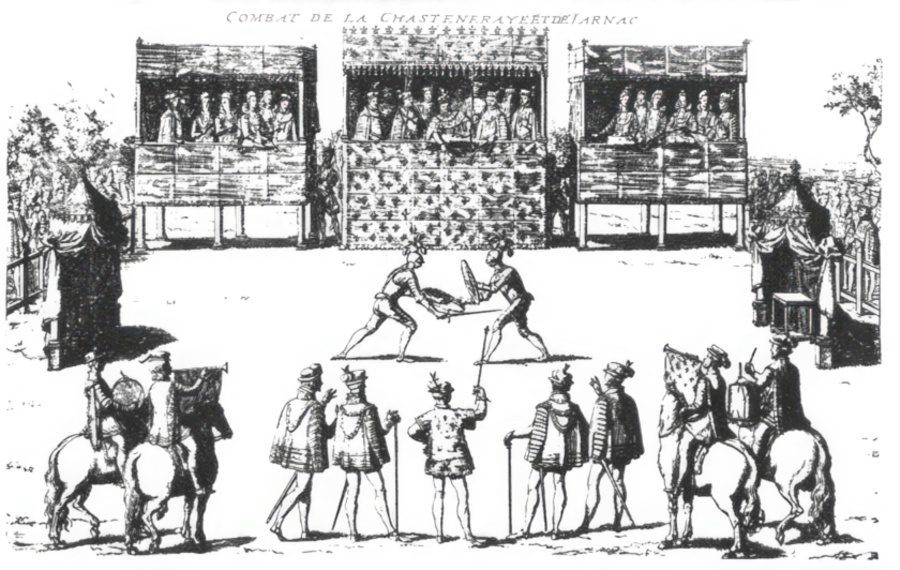
Fatal sword duels became so frequent that there were several attempts to prohibit them, from the Catholic Church to governments throughout Europe and the Americas. In some countries, the death penalty was imposed on those participating in duels.
In France, the last sword duel authorized by a French king was of Jarnac and Châtaigneraye in 1547. Still, the last recorded sword duel took place in the country in 1967 between politicians Gaston Defferre and Rene Ribiere.
As the judicial system of countries developed, sword duels gradually faded. By the end of the 18th century, before police forces were widely established, dueling pistols became common. Duels completely declined due to laws, judicial capacity, and changing culture.
Origin of Fencing
In the 13th or 14th century in Europe, fencing was a form of training for sword duels and warfare. By the 15th century, it evolved into a sport where points were awarded to a fencer when his sword touched his opponent.
Fencing became most popular in the 16th century when carrying swords became fashionable for civilians. Early fencers fought with rapiers and smallswords. By the 18th century, fencing masks and specialized weapons, such as the foil and the fencing sabre, were introduced.
By the 19th century, the épée was developed as a sporting version of the smallsword. Also, the foil and saber were too light and unable to give the experience of a real-life duel. Fencing eventually became part of the modern Olympic Games in 1896 and remained a significant part of the event.
Conclusion
Throughout history, sword duels were an honorable way to protect one’s honor or settle disputes. While judicial duels were legal practice, the duels of honor were illegal for the most part. Each duelist was willing to risk his life for it, so it’s unsurprising that some sword duels also left their mark on history.




